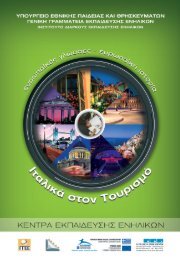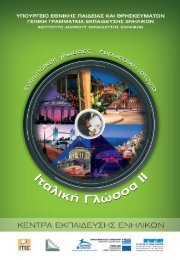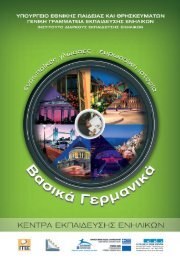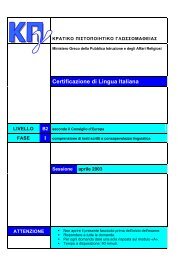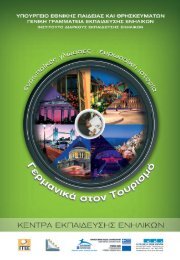Cataloging conventional and digital objects - Digital Library Logo
Cataloging conventional and digital objects - Digital Library Logo
Cataloging conventional and digital objects - Digital Library Logo
You also want an ePaper? Increase the reach of your titles
YUMPU automatically turns print PDFs into web optimized ePapers that Google loves.
important was the Panizzi’s British Museum Rules for the Compiling of the Catalogue<br />
(1841) <strong>and</strong> Cutter’s Rules for a printed dictionary catalogue (1876). These rules had the<br />
greatest effect on the later ones, such as the Anglo-American <strong>Cataloging</strong> Rules (ACCR).<br />
The AACR are detailed st<strong>and</strong>ard rules established in 1967 in order to catalog<br />
documents of the American, Canadian <strong>and</strong> British libraries <strong>and</strong> have been based on Paris<br />
Principles (1961). Very quickly, they took the form of “universal” rules, since they were<br />
adopted by many other countries. In 1978, they were published in a volume, followed by<br />
their revisions of 1998, in order to reflect the changes in formats, to which the<br />
information is now available. Their current publication is AACR2 Second ed., 2002<br />
Revision (with 2003, 2004, <strong>and</strong> 2005 updates) (AACR JCS, 2005). Rules concerning the<br />
Internet resources <strong>and</strong> other types of resources are included, without however constituting<br />
an entirely new code. The next edition, entitled “RDA - Resource Description <strong>and</strong><br />
Access”, is expected to be published in 2009. (AACR JCS, 2005)<br />
The need to st<strong>and</strong>ardize the cataloging processing on an international scale has leaded<br />
the IFLA (International Federation of <strong>Library</strong> Associations <strong>and</strong> Institutions) to the<br />
creation of a series of st<strong>and</strong>ards for bibliographic descriptions, known as International<br />
St<strong>and</strong>ard Bibliographic Descriptions (ISBDs). The ISBD is a group of st<strong>and</strong>ards whose<br />
creation started in 1971, having as an objective the preparation of the descriptive part of<br />
bibliographic records. The ISBD determines the structure that bibliographic records must<br />
have, the order of the elements of description <strong>and</strong> the punctuation system which offer the<br />
possibility to exchange bibliographic documents <strong>and</strong> to convert them into a format that is<br />
readable by a computer. (AACR2 Homepage, 2006) The incorporation of the ISBDs into<br />
the AACR2 structure has constituted one of the greatest developments in cataloging.<br />
The library collections, therefore the tools for bibliographic description, are<br />
determined by the format of the material included. While, initially, the collections were<br />
made of paper material, in the course of time new types of documents appear which lead<br />
to the creation of new tools, in order to make their library processing possible. The IFLA,<br />
driven by the increasing need for a separate ISBD concerning especially the computer<br />
files, published in 1990 the ISBD (CF- Computer Files). The electronic resources,<br />
however, are the products of a technology that is developing quite quickly. As a result of<br />
this assessment, IFLA decided to reassess <strong>and</strong> revise the ISBD (CF), which leaded in<br />
1997 to the publication of ISBD (ER- Electronic Resources). (IFLANET, 2005)<br />
Subject access tools<br />
The assignment of topical terms to the documents constitutes an effort of encoding<br />
their contents in order to make the search easier to the user. For their assignment, various<br />
tools have been created, which aim at the compilation of controlled vocabularies of<br />
topical terms assignment. The subject headings as well as the thesauruses are such tools.<br />
There are various tools for subject description of the documents available; among the<br />
most frequent are the <strong>Library</strong> of Congress Subject Headings (LCSH), the MeSH (Medical<br />
Subject Headings) <strong>and</strong> the Eurovoc.<br />
Although the creation <strong>and</strong> use of the LCSH started in 1897, their basic 9 th printed<br />
edition was published in 1980; now the 29 th edition is available. Apart from the printed<br />
format, the LCSH have been available in microform (microfilm <strong>and</strong> microfiche), from<br />
3





